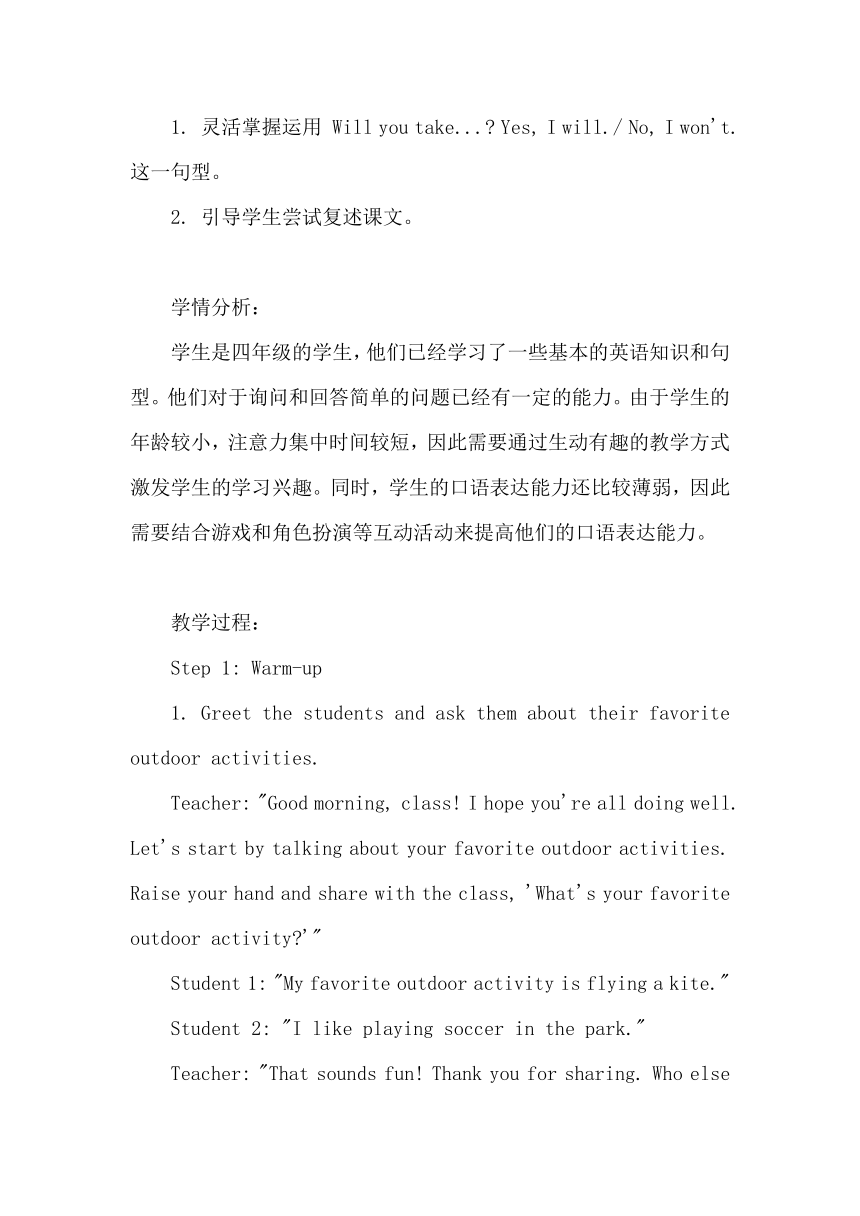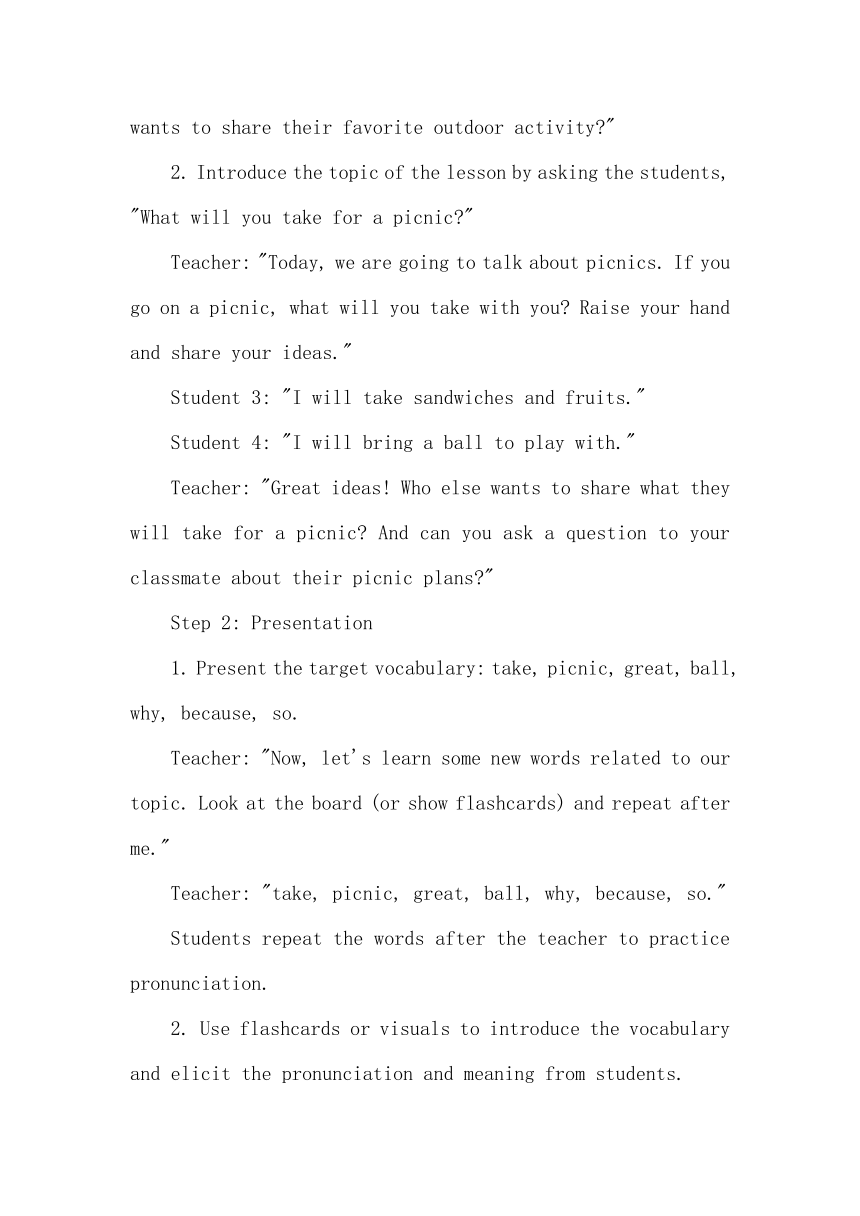Module 4 Unit 1 Will you take your kite?教案
文档属性
| 名称 | Module 4 Unit 1 Will you take your kite?教案 |  | |
| 格式 | docx | ||
| 文件大小 | 14.7KB | ||
| 资源类型 | 教案 | ||
| 版本资源 | 外研版(三年级起点) | ||
| 科目 | 英语 | ||
| 更新时间 | 2024-03-10 23:25:42 | ||
图片预览



文档简介
外研版四年级下册英语Module 4
《Unit 1 Will you take your kite?》教案
教材分析:
本节课所使用的教材是外研版(三起)四年级下册Module 4的第一个单元《Will you take your kite 》。该单元主要围绕询问他人的计划以及制定个人计划展开。教材中包含了与主题相关的词汇,句型和对话,通过课文内容的学习,培养学生的口语表达能力,增加他们的词汇量,提高他们的合作交流能力。
教学目标:
知识目标:
1. 学会单词:take, picnic, great, ball, why, because, so。
2. 学会运用句型:Will you take... 询问他人的计划及做出肯定与否定回答。
能力目标:
1. 能用所学句型:Will you take.. Yes, I will./ No, I won't. 谈论并制定计划。
情感目标:
1. 培养学生的合作交流能力。
2. 教育学生做一个有计划、有条理的人。
教学重点与难点:
1. 灵活掌握运用 Will you take... Yes, I will./ No, I won't. 这一句型。
2. 引导学生尝试复述课文。
学情分析:
学生是四年级的学生,他们已经学习了一些基本的英语知识和句型。他们对于询问和回答简单的问题已经有一定的能力。由于学生的年龄较小,注意力集中时间较短,因此需要通过生动有趣的教学方式激发学生的学习兴趣。同时,学生的口语表达能力还比较薄弱,因此需要结合游戏和角色扮演等互动活动来提高他们的口语表达能力。
教学过程:
Step 1: Warm-up
1. Greet the students and ask them about their favorite outdoor activities.
Teacher: "Good morning, class! I hope you're all doing well. Let's start by talking about your favorite outdoor activities. Raise your hand and share with the class, 'What's your favorite outdoor activity '"
Student 1: "My favorite outdoor activity is flying a kite."
Student 2: "I like playing soccer in the park."
Teacher: "That sounds fun! Thank you for sharing. Who else wants to share their favorite outdoor activity "
2. Introduce the topic of the lesson by asking the students, "What will you take for a picnic "
Teacher: "Today, we are going to talk about picnics. If you go on a picnic, what will you take with you Raise your hand and share your ideas."
Student 3: "I will take sandwiches and fruits."
Student 4: "I will bring a ball to play with."
Teacher: "Great ideas! Who else wants to share what they will take for a picnic And can you ask a question to your classmate about their picnic plans "
Step 2: Presentation
1. Present the target vocabulary: take, picnic, great, ball, why, because, so.
Teacher: "Now, let's learn some new words related to our topic. Look at the board (or show flashcards) and repeat after me."
Teacher: "take, picnic, great, ball, why, because, so."
Students repeat the words after the teacher to practice pronunciation.
2. Use flashcards or visuals to introduce the vocabulary and elicit the pronunciation and meaning from students.
Teacher: "Here are some flashcards with the new words. Can you say the word when I show you the flashcard "
Teacher shows the flashcards one by one, and students respond by saying the words and their meanings.
3. Drill the vocabulary with the whole class and individual students, ensuring correct pronunciation and understanding.
Teacher: "Now, let's practice saying the words together. Repeat after me: take, picnic, great, ball, why, because, so."
Step 3: Practice
1. Introduce the sentence pattern "Will you take... " Explain that this sentence pattern is used to ask someone about their plans.
Teacher: "Now, let's learn a new sentence pattern. Listen carefully. 'Will you take... ' This sentence pattern is used to ask someone about their plans. For example, 'Will you take your kite ' means asking if someone will bring their kite with them."
2. Model the sentence pattern and practice with the students.
Teacher: "I will show you some pictures, and I want you to ask me if I will take those things for a picnic. For example, 'Will you take a ball '"
Teacher shows a picture of a ball and elicits the question from students.
Students: "Will you take a ball "
Teacher: "Yes, I will take a ball."
3. Divide the students into pairs or small groups. Provide them with pictures or flashcards representing different picnic items.
4. In their pairs or groups, students take turns asking and answering questions using the sentence pattern.
Student A: "Will you take a kite "
Student B: "No, I won't take a kite."
5. Monitor the students' practice and provide assistance as needed. Encourage them to use complete sentences and respond using the target language.
Step 4: Consolidation
1. Read the dialogue from the textbook or display it on the board.
Teacher: "Now, let's read a dialogue about a picnic. Listen carefully."
Teacher reads the dialogue aloud while students follow along.
2. Have students work in pairs to practice the dialogue. They can take turns being Student A and Student B.
3. Encourage students to personalize the dialogue by changing the items and making their own plans.
Teacher: "Now, with your partner, change the items in the dialogue and make your own plans for a picnic. Practice the dialogue using your own plans."
4. Select a few pairs to perform their dialogues in front of the class.
Step 5: Wrap-up
1. Review the target vocabulary and sentence pattern by playing a game or doing a quick exercise.
Teacher: "Let's play a game. I will say a word, and you need to say a sentence using that word. For example, if I say 'picnic,' you can say 'I will take sandwiches for the picnic.'"
Repeat the game with different vocabulary words.
Summarize the lesson and ask students to share one thing they learned today.
板书设计:
Unit 1 Will you take your kite?
Vocabulary: take, picnic, great, ball, why, because, so
Sentence Pattern: Will you take... Yes, I will./ No, I won't.
教学反思:
本节课通过引入话题和活动,激发了学生的学习兴趣。通过图片、对话和角色扮演等多种形式的练习,学生掌握了目标词汇和句型,并能够灵活运用。同时,通过合作交流的活动,培养了学生的口语表达能力和团队合作意识。在教学过程中,我注意到学生对于课堂互动十分积极,但有些学生对于发音和句型的正确运用还存在一些困难。在以后的教学中,我会更多地进行口语练习,并提供更多的模仿和实践机会,帮助学生巩固所学内容。
《Unit 1 Will you take your kite?》教案
教材分析:
本节课所使用的教材是外研版(三起)四年级下册Module 4的第一个单元《Will you take your kite 》。该单元主要围绕询问他人的计划以及制定个人计划展开。教材中包含了与主题相关的词汇,句型和对话,通过课文内容的学习,培养学生的口语表达能力,增加他们的词汇量,提高他们的合作交流能力。
教学目标:
知识目标:
1. 学会单词:take, picnic, great, ball, why, because, so。
2. 学会运用句型:Will you take... 询问他人的计划及做出肯定与否定回答。
能力目标:
1. 能用所学句型:Will you take.. Yes, I will./ No, I won't. 谈论并制定计划。
情感目标:
1. 培养学生的合作交流能力。
2. 教育学生做一个有计划、有条理的人。
教学重点与难点:
1. 灵活掌握运用 Will you take... Yes, I will./ No, I won't. 这一句型。
2. 引导学生尝试复述课文。
学情分析:
学生是四年级的学生,他们已经学习了一些基本的英语知识和句型。他们对于询问和回答简单的问题已经有一定的能力。由于学生的年龄较小,注意力集中时间较短,因此需要通过生动有趣的教学方式激发学生的学习兴趣。同时,学生的口语表达能力还比较薄弱,因此需要结合游戏和角色扮演等互动活动来提高他们的口语表达能力。
教学过程:
Step 1: Warm-up
1. Greet the students and ask them about their favorite outdoor activities.
Teacher: "Good morning, class! I hope you're all doing well. Let's start by talking about your favorite outdoor activities. Raise your hand and share with the class, 'What's your favorite outdoor activity '"
Student 1: "My favorite outdoor activity is flying a kite."
Student 2: "I like playing soccer in the park."
Teacher: "That sounds fun! Thank you for sharing. Who else wants to share their favorite outdoor activity "
2. Introduce the topic of the lesson by asking the students, "What will you take for a picnic "
Teacher: "Today, we are going to talk about picnics. If you go on a picnic, what will you take with you Raise your hand and share your ideas."
Student 3: "I will take sandwiches and fruits."
Student 4: "I will bring a ball to play with."
Teacher: "Great ideas! Who else wants to share what they will take for a picnic And can you ask a question to your classmate about their picnic plans "
Step 2: Presentation
1. Present the target vocabulary: take, picnic, great, ball, why, because, so.
Teacher: "Now, let's learn some new words related to our topic. Look at the board (or show flashcards) and repeat after me."
Teacher: "take, picnic, great, ball, why, because, so."
Students repeat the words after the teacher to practice pronunciation.
2. Use flashcards or visuals to introduce the vocabulary and elicit the pronunciation and meaning from students.
Teacher: "Here are some flashcards with the new words. Can you say the word when I show you the flashcard "
Teacher shows the flashcards one by one, and students respond by saying the words and their meanings.
3. Drill the vocabulary with the whole class and individual students, ensuring correct pronunciation and understanding.
Teacher: "Now, let's practice saying the words together. Repeat after me: take, picnic, great, ball, why, because, so."
Step 3: Practice
1. Introduce the sentence pattern "Will you take... " Explain that this sentence pattern is used to ask someone about their plans.
Teacher: "Now, let's learn a new sentence pattern. Listen carefully. 'Will you take... ' This sentence pattern is used to ask someone about their plans. For example, 'Will you take your kite ' means asking if someone will bring their kite with them."
2. Model the sentence pattern and practice with the students.
Teacher: "I will show you some pictures, and I want you to ask me if I will take those things for a picnic. For example, 'Will you take a ball '"
Teacher shows a picture of a ball and elicits the question from students.
Students: "Will you take a ball "
Teacher: "Yes, I will take a ball."
3. Divide the students into pairs or small groups. Provide them with pictures or flashcards representing different picnic items.
4. In their pairs or groups, students take turns asking and answering questions using the sentence pattern.
Student A: "Will you take a kite "
Student B: "No, I won't take a kite."
5. Monitor the students' practice and provide assistance as needed. Encourage them to use complete sentences and respond using the target language.
Step 4: Consolidation
1. Read the dialogue from the textbook or display it on the board.
Teacher: "Now, let's read a dialogue about a picnic. Listen carefully."
Teacher reads the dialogue aloud while students follow along.
2. Have students work in pairs to practice the dialogue. They can take turns being Student A and Student B.
3. Encourage students to personalize the dialogue by changing the items and making their own plans.
Teacher: "Now, with your partner, change the items in the dialogue and make your own plans for a picnic. Practice the dialogue using your own plans."
4. Select a few pairs to perform their dialogues in front of the class.
Step 5: Wrap-up
1. Review the target vocabulary and sentence pattern by playing a game or doing a quick exercise.
Teacher: "Let's play a game. I will say a word, and you need to say a sentence using that word. For example, if I say 'picnic,' you can say 'I will take sandwiches for the picnic.'"
Repeat the game with different vocabulary words.
Summarize the lesson and ask students to share one thing they learned today.
板书设计:
Unit 1 Will you take your kite?
Vocabulary: take, picnic, great, ball, why, because, so
Sentence Pattern: Will you take... Yes, I will./ No, I won't.
教学反思:
本节课通过引入话题和活动,激发了学生的学习兴趣。通过图片、对话和角色扮演等多种形式的练习,学生掌握了目标词汇和句型,并能够灵活运用。同时,通过合作交流的活动,培养了学生的口语表达能力和团队合作意识。在教学过程中,我注意到学生对于课堂互动十分积极,但有些学生对于发音和句型的正确运用还存在一些困难。在以后的教学中,我会更多地进行口语练习,并提供更多的模仿和实践机会,帮助学生巩固所学内容。
同课章节目录
- Module 1
- Unit 1 She's a nice teache
- Unit 2 He's cool.
- Module 2
- Unit 1 London is a big city.
- Unit 2 It's very old.
- Module 3
- Unit 1 Robots will do everything.
- Unit 2 On Monday I'll go swimming.
- Module 4
- Unit 1 Will you take your kite?
- Unit 2 Will it be hot in Haikou?
- Module 5
- Unit 1 I was two then.
- Unit 2 They were young.
- Module 6
- Unit 1 Were you at home yesterday?
- Unit 2 Was it a big city then ?
- Module 7
- Unit 1 I helped Mum.
- Unit 2 Grandma cooked fish.
- Module 8
- Unit 1 They sang beautifully.
- Unit 2 I took some pictures.
- Module 9
- Unit 1 Did he live in New York ?
- Unit 2 Did you have a nice holiday?
- Review Module
- Unit 1
- Unit 2
- Module 10
- Unit 1 Did you fall off your bike?
- Unit 2 Sam had lots of chocolate.
